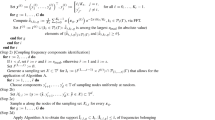Abstract
Given function values on a uniform grid in a domain Ω in \(\mathbb {R}^{d}\), one is often interested in extending the values to a larger grid on a box B containing Ω. In particular, we are interested in “periodic extensions.” For such extensions the discrete Fourier transform (DFT) of the resulting grid values on B is expected to provide good efficient approximation to the underlying function on Ω. This paper presents two different extension algorithms. The first method is a natural approach to this problem, aiming at achieving the fastest decay of the DFT coefficients of the extended data.The second is a fast algorithm which is appropriate for the univariate case and for limited cases of multivariate scenarios. It is shown that if a “good” periodic extension exists, the proposed method will find an extension with similar properties.










Similar content being viewed by others
References
Anand, A., Tiwari, A.K.: A Fourier extension based numerical integration scheme for fast and high-order approximation of convolutions with weakly singular kernels, arXiv:1810.03835
Adcock, B., Huybrechs, D., Martin Vaquero, J.: On the numerical stability of fourier extensions. Found. Comput. Math. 14(4), 635–687 (2014)
Boyd, J.P.: A comparison of numerical algorithms for Fourier extension of the first, second, and third kinds. J. Comput. Phys. 178.1, 118–160 (2002)
Bruno, O.P., Lyon, M.: High-order unconditionally stable FC-AD solvers for general smooth domains I. Basic elements. J. Comput. Phys. 229, 2009–2033 (2010)
Bruno, O.P., Han, Y., Pohlman, M.M. : Accurate, high-order representation of complex three-dimensional surfaces via Fourier continuation analysis. J. Comput. Phys. 227.2, 1094–1125 (2007)
Huybrechs, D.: On the Fourier extension of nonperiodic functions. SIAM J. Numer. Anal. 47.6, 4326–4355 (2010)
Gottlieb, D., Shu, C.W.: On the Gibbs phenomenon and its resolution. SIAM Rev. 39, 644–668 (1977)
Gruberger, N.: Spectral methods for the computation of discontinuous solutions. J. Sci. Comput. 4, 71–117 (1989)
Lyon, M., Bruno, O.P.: High-order unconditionally stable FC-AD solvers for general smooth domains II. Elliptic, parabolic and hyperbolic PDEs; theoretical considerations. J. Comput. Phys. 229, 3358–3381 (2010)
Moler, C.B.: Iterative refinement in floating point. J. ACM 14(2), 316–321 (1967)
Tadmor, E.: Filters, mollifiers and the computation of the Gibbs phenomenon. Acta Numer. 16, 305–378 (2007)
Whitney, H.: Analytic extensions of differentiable functions defined in closed sets. Trans. Amer. Math. Soc. 36, 63–89 (1934)
Wilkinson, J.H.: Rounding Errors in Algebraic Processes. Prentice-Hall (1963)
Author information
Authors and Affiliations
Corresponding author
Additional information
Publisher’s note
Springer Nature remains neutral with regard to jurisdictional claims in published maps and institutional affiliations.
Appendix
Appendix
1.1 A.1 Decay rate of discrete Fourier coefficients for periodic C M functions
In the theory of classical Fourier series, it is known that the Fourier coefficients {ck} of a CM periodic function decay as follows:
Using the equality
the above result is derived by applying M-times integration by part to the integral
Considering discrete fourier transform, we use the less known “summation by parts” formula:
In our case m1 = 0 and m2 = N − 1, and assuming periodicity, fN = f0 and gN = g0, we have as follows:
Using the above equality for the univariate discrete Fourier transform, we get, with fn = f(2nπ/N), n ∈N,
Assuming f ∈ C1, we have |Δfn| ≤ C1N− 1, and thus, we get the following:
Assuming f ∈ CM, we have |ΔMfn| ≤ CMN−M, and by applying the summation by parts M times, we obtain the following:
In the d-dimensional case, by performing summation by parts through each of the d-directions, we obtain the following:
Rights and permissions
About this article
Cite this article
Gruberger, N., Levin, D. Two algorithms for periodic extension on uniform grids. Numer Algor 86, 475–494 (2021). https://doi.org/10.1007/s11075-020-00897-7
Received:
Accepted:
Published:
Issue Date:
DOI: https://doi.org/10.1007/s11075-020-00897-7




